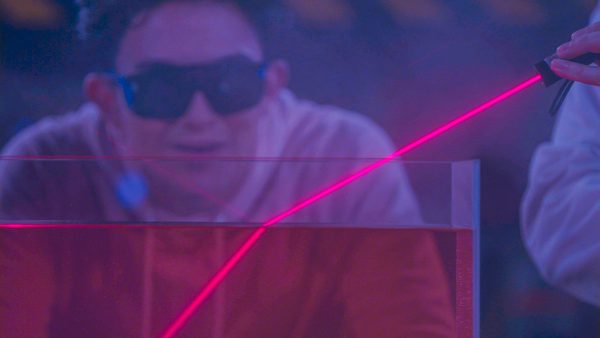Light Reflection Definition
Light reflection occurs when light waves bounce off matter, changing direction. For example, light reflects from mirrors at equal angles.
View Lesson on Wave Reflection, Absorption & Transmittance
Become a member to get full access to our entire library of learning videos, reading material, quiz games, simple DIY activities & more.
Become a member to get full access to our entire library of learning videos, quiz games, & more.
Plans & Pricingto watch this full video.

Access All Videos
and Lessons, No Limits.
Access All Videos

No credit card required,
takes 7 sec to signup.
No card required

Ready-to-go lessons
that save you time.
Ready-to-go lessons
If you are on a school computer or network, ask your tech person to whitelist these URLs:
*.wistia.com, fast.wistia.com, fast.wistia.net, embedwistia-a.akamaihd.net
Sometimes a simple refresh solves this issue. If you need further help, contact us.
Wave Reflection, Absorption & Transmittance
Fun Facts
- Ghost crystals become invisible in water, showing no reflection.
- When white light hits a leaf, all visible colors are absorbed except green, which is reflected onto your eyes.
- Light waves can travel through empty space, but sound waves cannot.
Why Do We Need To Know About Light Reflection
When we learn about how light reflects off surfaces, we can use this knowledge to work with light in many useful ways. This is important for lots of jobs and industries. For example, understanding light reflection helps us make solar panels that can turn sunlight into electricity. This is necessary for creating cleaner energy and moving away from using oil and coal.
This idea is also used in making sunglasses that keep bright light out of our eyes by reflecting it away. It’s important for making mirrors too, which are used in many fields like science, engineering to design better equipment, and even in fashion for creating sunglasses that protect our eyes.
Frequently Asked Questions
Check out the Full Lesson on Wave Reflection, Absorption & Transmittance
In this lesson, we learn that:
- All waves have properties like amplitude, wavelength and frequency.
- Sound waves need matter to travel through. Light waves can travel through empty space.
- Waves interacting with matter can be reflected, absorbed, transmitted and refracted.
Related Topics
- Binary Code Definition
- Bioindicator Definition
- Cell Definition
- Chemical Reaction Definition
- Circuit Definition
- Climate Definition
- Coastal Erosion Definition
- Competition Definition
- Conduction Definition
- Definition Of Engineering
- Definition Of Evidence
- Definition Of Human Body Systems
- Definition Of Non-living Things
- Definition Of Science
- Dichotomous Key Definition
- Digestive System Definition
- Divergent Boundary Definition
- Electromagnetic Spectrum Definition
- Electron Definition
- Endoskeleton Definition
- Energy Transfer Definition
- Food Web Definition
- Force Definition
- Fossil Definition
- Frequency Definition
- Geologic Time Scale Definition
- Gravity Definition
- Lever Definition
- Light Reflection Definition
- Light Source Definition
- Light Year Definition
- Liquid Definition
- Marsupial Definition
- Mineral Definition
- Newton’s 1st Law Of Motion Definition
- Paleontologist Definition
- Predation Definition
- Prevailing Winds Definition
- Prey Definition
- Push Definition
- Reflecting Surface Definition
- Respiratory System Definition
- Salt Water Definition
- Solution Definition
- Total Eclipse Definition
- Trait Definition
- Wave Reflection Definition
- Wavelength Definition
Start a Free Trial Today. Get a $5 Amazon Gift Card!
Teachers! Start a free trial & we'll send your gift card within 1 day. Only cards left. Try it now.
Select Grade
Select Subject
This email is associated with a Science Kit subscription. Kit subscriptions are managed on this separate page: Manage Subscription

-
Download InvoiceScience & Math$/yr
-
Download InvoiceScience Only$/yr

access all lessons
• No credit card required •
"My students loved the videos. I started the video subscription in May and used them as a review before the state test, which I know contributed to 100% of my class passing the state test."
Rhonda Fox 4th Grade Teacher, Ocala, Florida
• No credit card required •
"My students loved the videos. I started the video subscription in May and used them as a review before the state test, which I know contributed to 100% of my class passing the state test."
Rhonda Fox 4th Grade Teacher, Ocala, Florida
• No credit card required •
Already a member? Sign In
* no credit card required *

* no credit card required *
* no credit card required *


no credit card required
Skip, I will use a 3 day free trial
Enjoy your free 30 days trial
-
Unlimited access to our full library
of videos & lessons for grades K-5. -
You won’t be billed unless you keep your
account open past your 14-day free trial. -
You can cancel anytime in 1 click on the
manage account page or by emailing us.
-
Unlimited access to our full library of videos & lessons for grades K-5.
-
You won't be billed unless you keep your account open past 14 days.
-
You can cancel anytime in 1-click on the manage account page.
Cancel anytime in 1-click on the manage account page before the trial ends and you won't be charged.
Otherwise you will pay just $10 CAD/month for the service as long as your account is open.
Cancel anytime on the manage account page in 1-click and you won't be charged.
Otherwise you will pay $10 CAD/month for the service as long as your account is open.
We just sent you a confirmation email. Enjoy!
DoneWe use cookies to make your experience with this site better. By using this site you agree to our use of cookies. Click "Decline" to delete and block any non-essential cookies for this site on this specific property, device, and browser. Please read our privacy policy for more information on the cookies we use.Learn More
We use cookies to improve your experience. By using this site, you agree to our use of cookies. Click "Decline" to block non-essential cookies. See our privacy policy for details.Learn More



























































































































